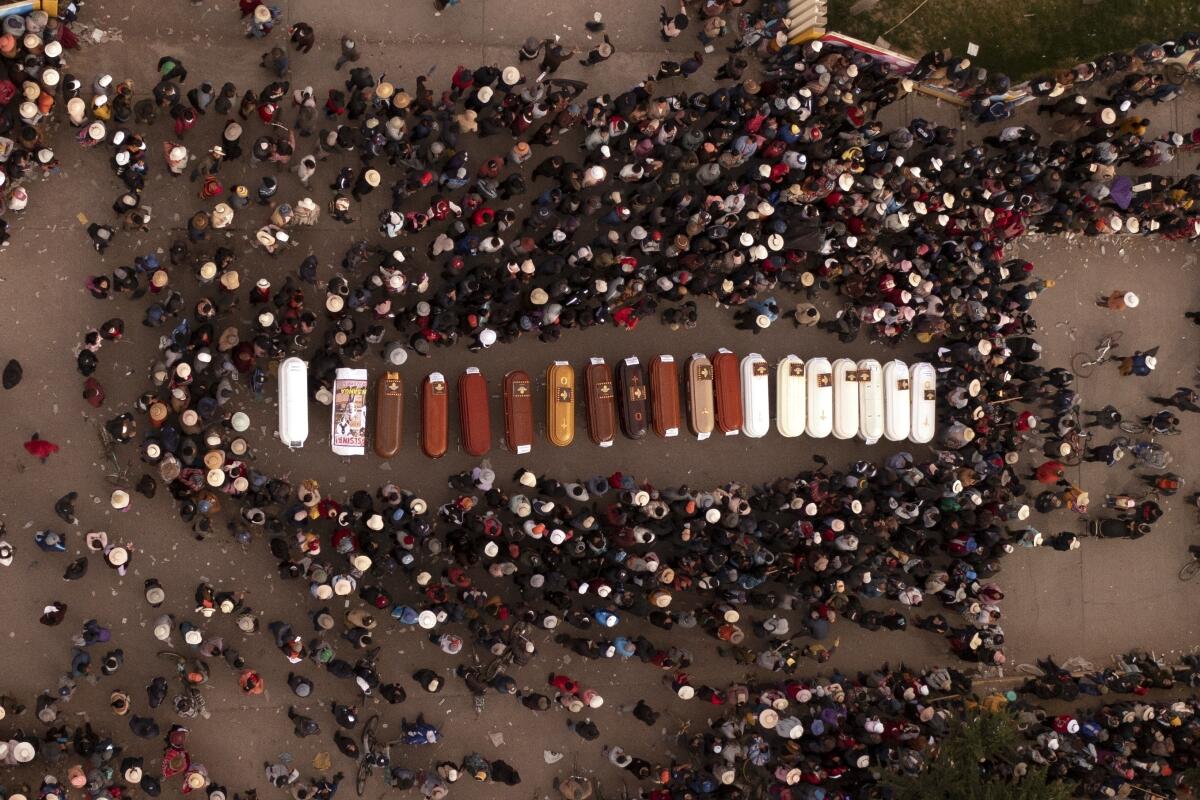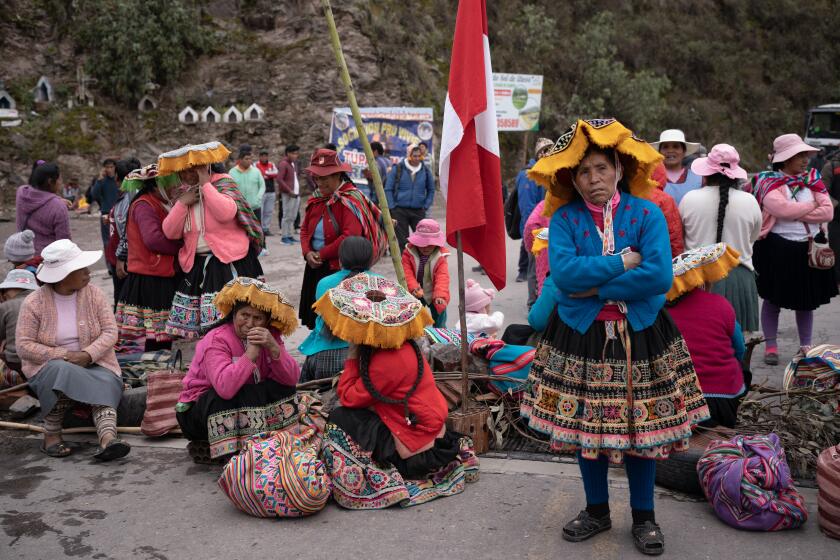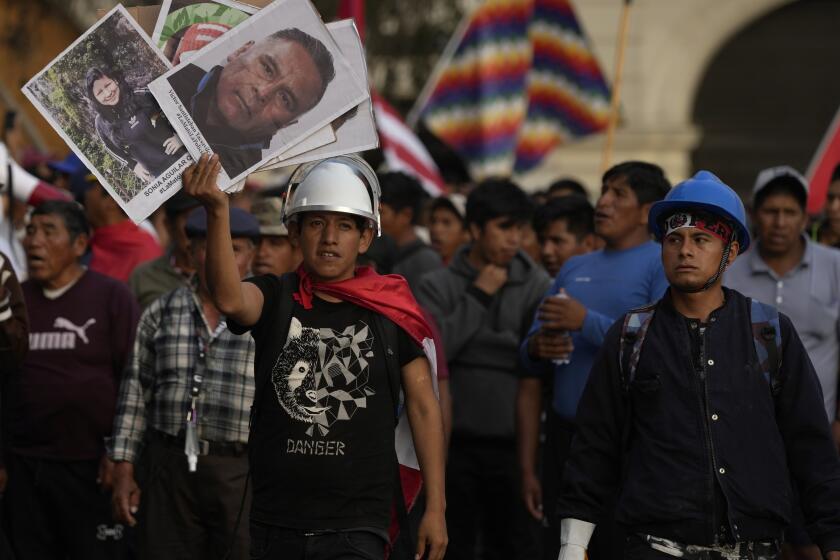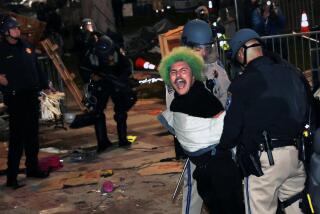Autopsies show 30 people died from gunfire in Peru protests

- Share via
LIMA, Peru — In autopsy after autopsy, Peruvian anti-government protesters share the same cause of death: “firearm projectile.”
Christian Armando Mamani, a 22-year-old musician, was protesting in a southern city when a bullet entered the left side of his torso and pierced both of his lungs.
The same January day, Roger Rolando Cayo, a 25-year-old protester, died when a shot ripped through his eye and destroyed his brain.
Human rights groups — including the United Nations — have called on the Peruvian government to investigate claims of excessive force used by police and soldiers during recent protests that have left 49 civilians dead, and the autopsies provide some evidence of the alleged use of lethal ammunition.
Thirty of the 32 forensic reports obtained by the Associated Press list gunfire as the cause of death. Some of the reports detail bullet calibers similar to those used by security forces in Peru, which experts believe indicates that police and soldiers violated their own operations manuals prohibiting shooting directly toward protesters unless there’s a serious risk to their life.
The findings come as Peru struggles to recover from the political crisis that hit the country late last year. In December, then-President Pedro Castillo, who was facing several corruption investigations, attempted to dissolve Congress but was instead impeached, arrested and replaced by the vice president. Demonstrations stretched out to February, mostly in southern Peru where the former leader has had more support, triggering the worst political violence the country has seen in more than two decades.
Protest in Peru aimed at removing the president has become a rebellion of the Indigenous and poor, pushing for broad political, economic and social changes.
In the southern city of Juliaca, protesters clashed with police outside the airport on Jan. 9 in what would be the deadliest demonstration. Autopsies confirmed that 18 people died from gunfire that day. Among the dead were a 16-year-old student whose left lung was perforated by a 7.62-millimeter bullet that lodged in his abdomen and a 17-year-old university student who died from a 9-millimeter bullet wound.
The Associated Press obtained a copy of a document from the federal prosecutor’s office that listed the weapons used by police in Juliaca in December, including 7.62-millimeter AKM assault rifles and 9-millimeter Beretta and Sauer handguns.
In Peru, civilians are only permitted to own guns with low calibers. High-caliber guns — including the 7.62- and 5.56-millimeter types mentioned in the forensic reports — are exclusively for the use of security forces.
Carmen Rosa Cardoza, a Peruvian forensic anthropologist, told the Associated Press that the autopsies show a pattern of a “disproportionate use of force.”
“In the injuries by the firearm projectiles, there’s a pattern linked to human rights violations,” she said, noting that most of the fatal wounds are on the head, neck, thorax and abdomen. The shooters, she said, “are targeting those regions.”
Protesters are still staging roadblocks in some parts of the country and calling for the resignation of the new president, Dina Boluarte, whom they blame for the deaths of dozens of demonstrators in areas inhabited largely by Indigenous people.
The attorney general’s office has launched an investigation — including Boluarte — that hasn’t led to any arrests.
The ousting of leftist president Pedro Castillo has spurred clashes between the Indigenous poor and the coastal ruling class that have spilled into Los Angeles.
“These numbers turn Peru into a champion of repression, when compared to other democracies in Latin America” said Jo-Marie Burt, a Peru expert at the Washington Office on Latin America, a human rights group. “Only openly authoritarian nations like Venezuela and Nicaragua” have had more deaths during recent protests, she said.
Peruvian government officials have not responded to the Associated Press’ request on whether they gave police orders to shoot at protesters after massive demonstrations broke out in the south, where Castillo’s removal angered people frustrated with the nation’s Congress, which has has become one of the nation’s least trusted institutions.
Boluarte has blamed “radicals” linked to illegal mining and the drug trade for the chaotic protests, which have included the occupation of airports and attacks against police bases. But the autopsies, videos and witness testimonies paint a different picture of the violence, in which the nation’s security forces also appear to have had a significant role.
On Dec. 15, demonstrators gathered outside the Ayacucho airport, where security camera videos show soldiers firing Galil rifles horizontally instead of pointing the weapons upward, away from protesters. Forensic reports show 10 protesters died from gunfire in Ayacucho that day, although none of the corpses contained bullets.
Three days later, an Associated Press reporter walked through the area where the shots were fired and found several cases for the 5.56-millimeter ammunition used with Galil rifles on the floor.
In Andahuaylas, another southern city, 18-year-old protester Wilfredo Lizarme was killed by a bullet to his back on Dec. 11, according to forensic reports. His sister, Carla, found a shell casing close to his body with the legend “PNP 7,62x39,” the initials of Peru’s national police and the same caliber as the bullets used by police in other parts of the country.
The Associated Press has repeatedly sought a response from Peru’s government about the allegations of police violence against protesters but has yet to receive one.
In a January news conference, Boluarte evaded questions about whether she ordered the police to use firearms to break up protests and said that police officers had conducted themselves in an “immaculate” manner.
Police say officers have been trying to defend themselves from violent protesters who have attacked them with improvised weapons, including slingshots and fireworks launched from metal tubes. According to Peru’s National Police, 43 police stations were attacked over the past three months and more than 850 officers sustained injuries during the protests, while one officer was burned alive inside his patrol car in Juliaca.
However, human rights groups contend that police haven’t followed all regulations.
Mar Pérez, a researcher for the Peruvian National Coordinator for Human Rights group, said the manual for use of force stipulates that officers can only use firearms and shoot to kill when their lives are at risk.
The fact that there are violent people in a protest doesn’t justify the use of firearms or authorize police to dissolve the entire protest, said Paulo Abrao, a former executive secretary of the Inter-American Commission on Human Rights.
The Inter-American Commission on Human Rights requested in January that Peru’s government launch an inquiry into the use of weapons by police during the protests. Then, in the last week of February, the U.N. high commissioner for human rights sent a document to Peru’s government that expressed the organization’s concern with the deaths of protesters and gave the government 60 days to provide more information on what it is doing to investigate the killings and implement policies that prevent the excessive use of force in protests.
The National Coordinator for Human Rights says that since 2003, it has documented 160 deaths during protests in Peru. Pérez said that “not a single police officer” has been convicted in these killings.
More to Read
Sign up for Essential California
The most important California stories and recommendations in your inbox every morning.
You may occasionally receive promotional content from the Los Angeles Times.















